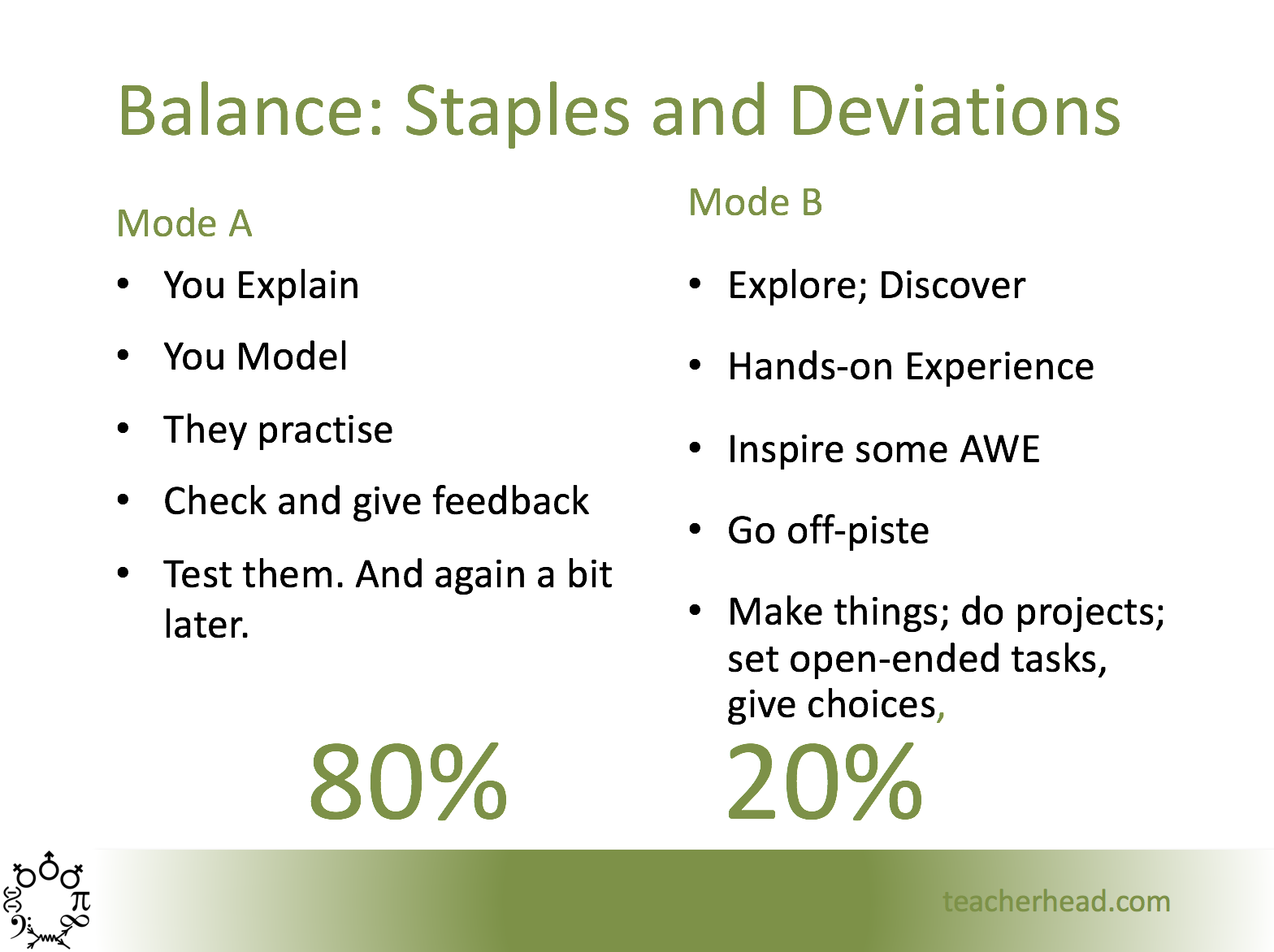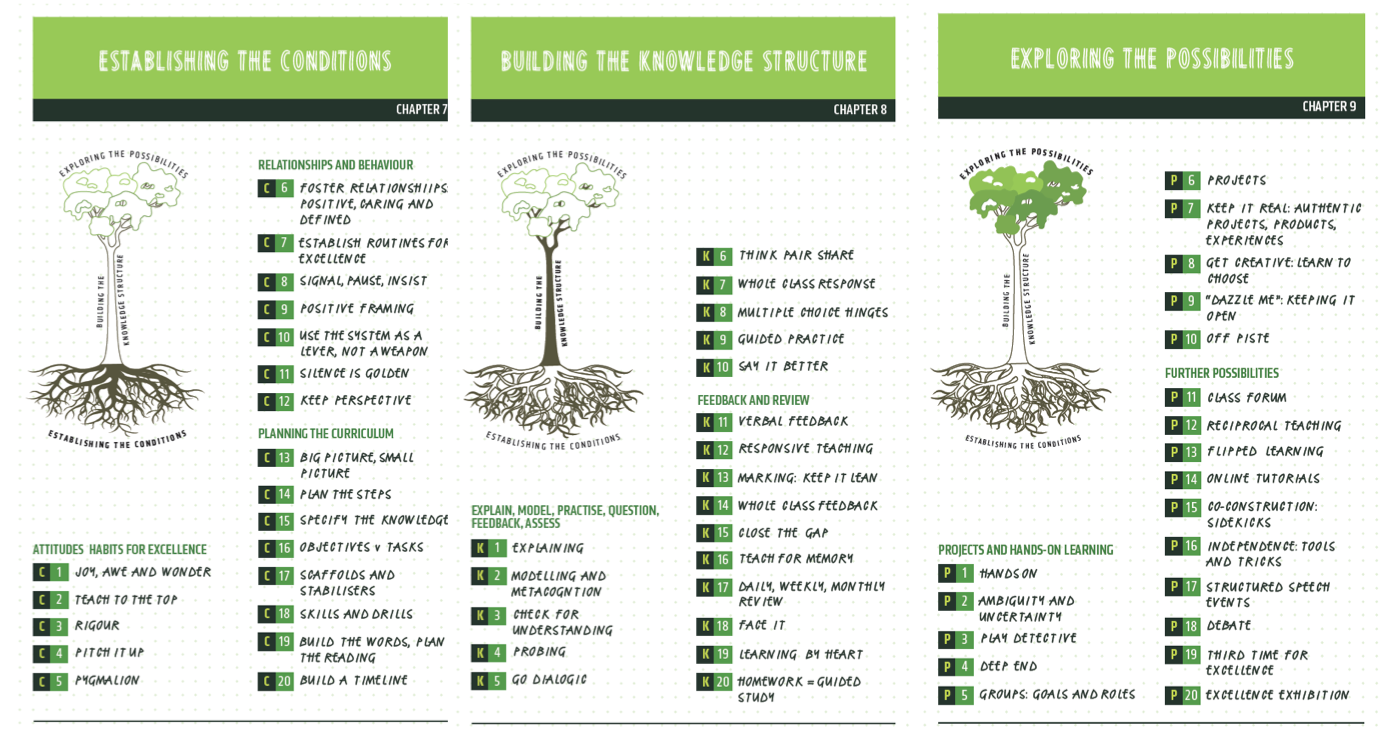The slide below is one that I often use in my CPD presentations. The percentages are revealed after some reflection time. I’m keen to stress that, as a physics teacher, this is how I see my time is divided. I am not recommending this particular split; I am reporting my experience of it. Other teachers might have a different sense of it – although I do often get quite strong agreement.
I invented Mode A: Mode B as a short-hand for different elements in the teaching-mix to get across the idea that, whilst some strategies are much more likely to be effective for certain purposes, there are multiple purposes – so it’s likely that we’ll need a mix of approaches over time. This links to the balanced diet idea I wrote about a long time ago.

Beyond the early years, a lot of the time, if not most of the time, teachers are trying to teach specific knowledge and skills to their novice students. This requires good instructional methods; these are the staples of knowledge building in very many subjects and contexts: this is Mode A. In Chapter 8 of The Learning Rainforest – Building the Knowledge Structure – I am essentially describing Mode A teaching: explaining, modelling, questioning, giving feedback, the role of practice.

However, possibly within any unit of the curriculum and certainly in the curriculum overall, we need some other approaches too. Learning takes many forms and there need to be some deviations; a slice or chunk of Mode B. I can’t imagine a truly great curriculum where students do not, at some point, have a range of hands-on experiences, learn to make choices, explore ideas independently to find patterns and rules or develop original ideas. They need to have the chance to make things, to work with each other and to pursue some areas of the curriculum in an extended fashion through projects. It’s just a question of these things being sequenced and structured well so that the learning builds on secure foundations. I explain this at length in Chapter 9 of The Learning Rainforest – Exploring the Possibilities.
Of course the two modes overlap. Yes, you can inspire awe through straight-forward instructional teaching (not something special you’ve laid on); yes you can build some types of knowledge through hands-on learning and open-ended projects. The key for me, in my message to teachers, is to be deliberate about the teaching approach you adopt – using your evidence-informed wisdom to ensure that the approach matches the demands of the curriculum content.
I also often say that Mode A is the place to focus CPD time; it’s usually the hard bit and everyone needs to be able to do this really well. You can’t go off piste until there is a piste – so to speak! But, in promoting excellent instructional Mode A teaching, I am not saying that Mode B doesn’t matter. It does. A lot. However, it’s a bit like the ingredients in a balanced diet. Some things only need to be present in very small doses to keep us fit and healthy – but they are still absolutely essential. We’d be much weaker specimens without them.
A related post is about how this plays out in the way we interpret findings from research: You’re doing it all wrong: context and complexity in Ed-research and debate.
Here I stress that the need for balance and nuance in understanding research does not mean anything goes. That’s always the risk. But I’ll leave you to consider what your equivalent of my 80:20 split might be.
UPDATE
I took part in a Seneca Learning webinar last week that explored the Mode A Mode B concept. It’s probably the most succinct explanation I’ve given and the questions afterwards were excellent including my views on flipped learning, growth mindset, using knowledge organisers, tech teams, how to deliver Mode B in more disadvantaged contexts, ‘skateboarding lessons’…. and more.

Excellent sense, thoughtfully put. Like the idea of thinking about that 80/20 balance. Obviously written by a teacher who understands learning (as different to teaching). Reminds me of a quote, about giving a talk, “Tell them what they need to know, not what you want to tell them.”
LikeLiked by 1 person
[…] simply because it is unfeasible to be constructivist all the time. I am fond of Tom Sherrington’s 80/20 balance, with simple, teacher-led lessons making up the majority, building knowledge and skills, with a […]
LikeLiked by 1 person
[…] Mode A + Mode B = Effective teaching and a rich enacted curriculum […]
LikeLike
Reblogged this on DT & Engineering Teaching Resources and commented:
Mode A + Mode B = Effective teaching and a rich enacted curriculum
LikeLike
[…] via Mode A + Mode B = Effective teaching and a rich enacted curriculum […]
LikeLike
[…] explicitly: A Balanced Diet for Learning and Teaching. I have also developed the very simple Mode A: Mode B concept to capture the mix of instructional teaching and other forms of learning that constitute a […]
LikeLike
[…] in the right balance, there is ample scope for teachers to include elements of ‘Mode B’ teaching – to introduce set-piece elements of collaborative learning, extended projects and to express […]
LikeLike
[…] So let me be very clear, I am not arguing for “all DI all the time.” There is a place for less-guided instruction (particularly to avoid expertise reversal effect), but certainly not at the beginning of the learning process. In addition, as constructivist, minimally-guided techniques often require teachers to combine and switch between DI, inquiry, and problem-based learning simultaneously in lessons (a legitimately difficult undertaking for any teacher), it would make far greater sense to equip new teachers with a strong skill set in explicit, direct instruction before adding in constructivist approaches. I personally aim for a 80% – 20% split, as described by Tom Sherrington. […]
LikeLiked by 1 person
[…] So let me be very clear, I am not arguing for “all DI all the time.” There is a place for less-guided instruction (particularly to avoid expertise reversal effect), but certainly not at the beginning of the learning process. In addition, as constructivist, minimally-guided techniques often require teachers to combine and switch between DI, inquiry, and problem-based learning simultaneously in lessons (a legitimately difficult undertaking for any teacher), it would make far greater sense to equip new teachers with a strong skill set in explicit, direct instruction before adding in constructivist approaches. I personally aim for a 80% – 20% split, as described by Tom Sherrington. […]
LikeLiked by 1 person
[…] that post, I didn’t know what that balance would look like. A week or so later, I came across Tom Sherrington’s blog where he outlines what he calls “Mode A: Mode B” […]
LikeLike
[…] In that post, I didn’t know what that balance would look like. A week or so later, I came across Tom Sherrington’s blog where he outlines what he calls “Mode A: Mode B” […]
LikeLike
[…] don’t practise and therefore can’t get better or more fluent. This where my simple Mode A Mode B model kicks […]
LikeLike
[…] sense is that, as with the forms of lesson activities I describe as Mode A and Mode B teaching, there is the need to provide a diet of homework that blends these different opportunities […]
LikeLike
[…] Wit & Wisdom, and Eureka), I’m…legitimately hopeful. These curricula, while including appropriate and deliberate space for inquiry and discovery, largely fall more in the realm of teacher-led, explicit instruction. By including detailed lesson […]
LikeLike
[…] Mode A + Mode B = Effective teaching and a rich enacted curriculum […]
LikeLike
[…] Mode A + Mode B = Effective teaching and a rich enacted curriculum: A model for balancing a core of instructional teaching with a range of other forms of teaching that combine to make teaching and learning, deep, interesting and varied. […]
LikeLike
This is great! Would you mind sharing the CPD PPT with me?
LikeLike
This is great! Would you mind sharing me a copy of the CPD PPT? Have a great summer!
LikeLike
[…] Sherrington, Tom. “Mode A Mode B = Effective Teaching and a Rich Enacted Curriculum.” Teacherhead, 8 June 2018, teacherhead.com/2018/04/22/mode-a-mode-b-effective-teaching-and-a-rich-enacted-curriculum/ […]
LikeLike
[…] post, I didn’t know what that balance would look like. A week or so later, I came across Tom Sherrington’s blog where he outlines what he calls “Mode A: Mode B” […]
LikeLike